
We are descended from several Revolutionary War patriots. On the Fike side John Thomas Fike and his sons Malachi, James, and our ancestor Tyre Fike. William England and John Phillips were loyalist British tory soldiers. James Stark, Hugh Henry, and John Donelson are Fike ancestors who served in the revolution. After the war Donelson and the Henrys lead an expedition to found what is now Nashville, Tennessee. One of John’s daughters married President Andrew Jackson. We are descended from his second daughter. The Donelsons are buried at the church on the grounds of “The Hermitage”, Jackson’s Nashville plantation. Two other patriots from our Dutch Hoagland ancestors on the Andrew side were Jacobus Quick and Edward Bunn. And on the Lowe side we have John Farley, Jr.
Fike Family Revolutionary War Patriots
John Thomas Fike and Sons
John Thomas Fike and his sons fought in the Regulator Movement in North Carolina, one of the first armed revolts of the colonists against the British Crown. They also fought in the North and South Carolina militias during the Revolutionary War. One of our uncles, James Fike, was in George Washington’s Continental Army and died of disease during the time that the army was encamped at Valley Forge.
The Regulator Movement:
“During the years leading up to the American Revolution many North Carolina people became strongly discontented with the way the provincial government was handling the colony’s affairs. However, their quarrel was not with the form of government or the colony’s laws but with abuses by government officials.
Grievances affecting the daily lives of the colonists included excessive taxes, dishonest sheriffs, and illegal fees. Scarcity of money contributed to the state of unrest. Those living in the western part of the province were isolated and unsympathetic with the easterners and it was in those frontier counties that the War of the Regulation began.
Minor clashes occurred until the spring of 1768, when an association of “Regulators” was formed. Wealthier colonists considered them to be a mob. The Regulators never had an outstanding leader, though several men were prominent in the movement; including James Hunter, Rednap Howell, William Butler, and Herman Husband. Husband, a Quaker and follower of Benjamin Franklin, circulated political pamphlets advocating peaceful reform.
Discouraged over failing to secure justice through peaceful negotiations, the reformers took a more radical stand. Violence, lawlessness, and terrorism reigned. When the government retaliated against them, the Regulators defiantly refused to pay fees, terrorized those who administered the law, and disrupted court proceedings.
It fell to royal governor William Tryon to bring the backcountry revolt to a speedy conclusion. In March 1771, the governor’s council advised Tryon to call out the militia and march against the rebel farmers.
The Battle of Alamance
The battle began on May 16 after the Regulators rejected Tryon’s suggestion that they disperse peacefully. Lacking leadership, organization, and adequate arms and, ammunition the Regulators were no match for Tryon’s militia. Many Regulators fled, leaving their bolder comrades to fight on.
The rebellion of the Regulators was crushed. Nine members of the king’s militia were killed and 61 wounded. The Regulator losses were much greater, though exact numbers are unknown. Tryon took 15 prisoners; seven were hung later. Many Regulators moved on to other frontier areas beyond North Carolina. Those who stayed were offered pardons by the governor in exchange for pledging an oath of allegiance to the royal government.
The War of the Regulation illustrates how dissatisfied much of the population was during the days before the American Revolution. The boldness displayed by reformers opposed to royal authority provided a lesson in the use of armed resistance, which patriots employed a few short years later in the American War for Independence.”
John Fike also served in the North Carolina militia providing unspecified services to the Revolutionary Army. In 1776 he was 58 years old.
Tyre served in the South Carolina militia and supplied provisions in 1779. In the records his name was spelled Phyke.
British Loyalist Soldiers:
Both of Electa England’s (Fike side) grandfathers fought for the British in the Revolutionary War. William England came to North America as a British soldier during the French and Indian War and married the daughter of a German immigrant. John Phillips was descended from Dutch immigrants and was living in the Mohawk River valley at the start of the war.
William England 1740-1796
William was born in 1740 in Stone, Staffordshire, England to William England and Hanna Bentley. He came to North America in 1753.
He served in the British Army during the French and Indian War. He was a member of the 3rd Battalion of the 60th Regiment “the Royal American’s” in the company of Gottileb Adam . The Third Battalion was formed in Albany in 1757. In the units first engagement a portion of the Battalion was sent to reinforce Fort William Henry, with the remainder staying in Fort Edwards. The French with their Indian allies attacked Fort William Henry, this attack resulted in a massacre that was recounted in James Fillmore Cooper’s novel the last of the Mohicans. From Fort Edward the battalion moved during the winter of 1758 to Dartmouth, Nova Scotia. In June of 1758 they were attached to the Army of Colonel Jeffery Amherst that began the battle of Louisbourg. Ultimately, they participated in the Battle of Quebec, that led to The Treaty of Paris on February 10 1763 which led to the transfer of all Colonial Authority in North America East of the Mississippi from France to England.
In 1770 William married Anna Maria Schneider from Rhinebeck, Dutchess, New York. They had a Girl Hanna and a boy John Peter.
The family lived in Saratoga until 1773 or 1774 when he purchased 25 Acres In Kingsbury, New York. He cleared that property and built a house.
William joined the Loyalists militia In June 1777 as a Sergeant, The unit he joined was Called “His Majesties American Volunteers” under the command of Captain Commandant Captain Daniel McAlpin This unit was attached to General John Burgoyne’s as it marched south from Canada on the “Saratoga Campaign.
Burgoyne’s army was ultimately surrounded by rebel forces in the second battle of Saratoga. He Surrendered his total army of 6200 men on October 17, 1777. Many of the local loyalist escaped before the surrender and returned to Canada. William England is one of the loyalist that makes his return to Canada and is classified as a “non-Convention” solider, which means he is not subject the terms of the surrender which required all British soldiers that surrendered to not participate in future war activities and leave the country.
William’s wife Maria and 3 children left their farm in Kingston New York and in September of 1778 and were forced to leave New York for Canada Under white “flag”.
William and Maria’s Land in Kingbury was confiscated After the war they claimed that loss. Stating:
“Says he purchased 25 acres in April 1775. from Michael Hoofnail, was to Pay 15lbs York in work to be done. Paid 10lbs in work. Cleared 8 acres & built a House. This land has been Confiscated as the Property of Michael Hoofnail & does not know whether he has not Claimed for it. Lost Grain, Farming & Carpenters Tools, Household Furniture. England, William of Kingsbury. Memorial, now of Yamachichi, Canada [written in his own hand], 27 February 1786. He served in the French War in the 60th Regt. In 1777 he joined Jessup’s Corps as Sgt. and served until December 1783. Claim for 25 acres; a house; crops, etc.“
William’s family made their way to the Loyalist Refugee camp in Machiche first appearing there in December of 1778. The family will remain in this camp 3 and 1/2 years until July of 1783. While Mary is in the camp she has 3 more children. During this time William continues to serve in the Loyalist Militia. For a period of time after January of 1781 he provides security for the women and children at Machiche.
The settlement closed in 1785 and William became in charge of both Gugy’s windmill and sawmill.
William England died on January 6, 1796 and his funeral services took place two days later in the St. James Protestant Church in Trois-Rivieres. He was 55 years old.
Historical Context:
The following quote is from the Regimental history of the 60th, “A part of the 3rd Battalion had in the meantime moved up from Albany to Fort Edward, whence, on August 2, a detachment 200 strong under John Young (now lieutenant – colonel) was dispatched by colonel Webb to form part of the garrison of Fort William Henry under Colonel Monro of the 35th. The next day this fort, with its wooden parapet, and garrison of 2200 men, one-third only being British regular troops, was besieged by a sudden advance of (5000 French and 1600 Indians under the Marquis de Montcalm. Webb from Fort Edward, fourteen miles distant, had reinforced Monro with 1000 men and had only 1200 remaining. Rightly or wrongly he made no further attempt to aid him. The parapet was quickly battered down by the French, and the British guns were silenced. More than 3110 of the garrison had been killed and wounded and small—pox was raging in the fort. On August 9 Colonel Young, who bad been wounded, was dispatched by Monro to negotiate terms of surrender. It was stipulated that the British should march to Fort Edward in safety with their small arms and one field-gun. The fort then capitulated. Montcalm, assisted by the regular officers of the French army, of which no less than six battalions were present, made every personal attempt honorably to fulfill the treaty. But why did he not get his regular troops under arms to enforce it? The fact the French did not dare to offend their Indian allies, and the Canadian militia thirsted for blood. A terrible scene ensued. Undeterred by their white comrades, the Indians broke in upon the prisoners and massacred about 80 soldiers, besides women and children. The story of the massacre of Fort William Henry is told by Fennimore Cooper in his book “The Last of the Mohicans”. This atrocity, like that of Cawnporn a century later, created a furor which took many years to subside, and is not forgotten at the present day. Its immediate result was that ‘Remember William Henry’ became the stern reply to many a piteous appeal for quarter by Frenchman or Canadian. By death, disease, wounds, and probably massacre the 3rd Battalion seems to have suffered a loss of about 80 men in this affair. It is not easy to replace them. The battalion was mustered at Fort Edward in October and found to number 30 officers and 413 of all other ranks. Eleven officers and 325 of other ranks are described as ‘absent’.”
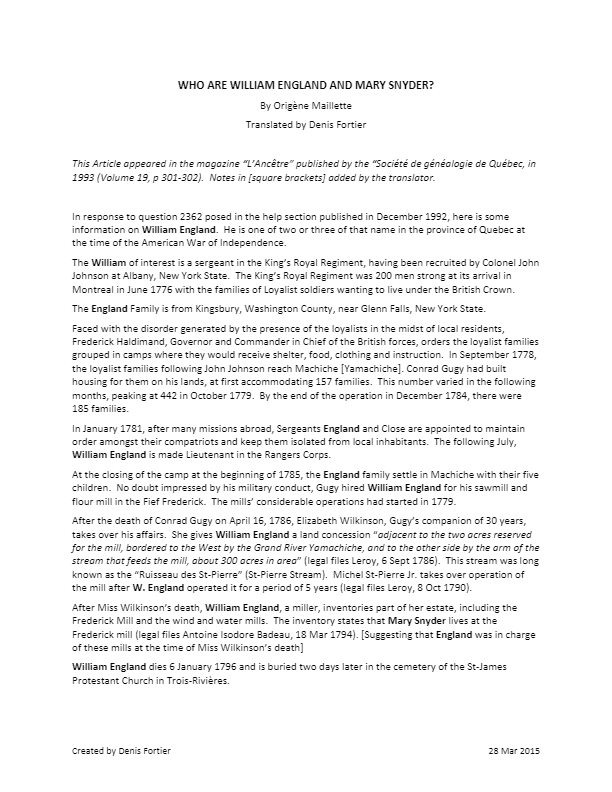
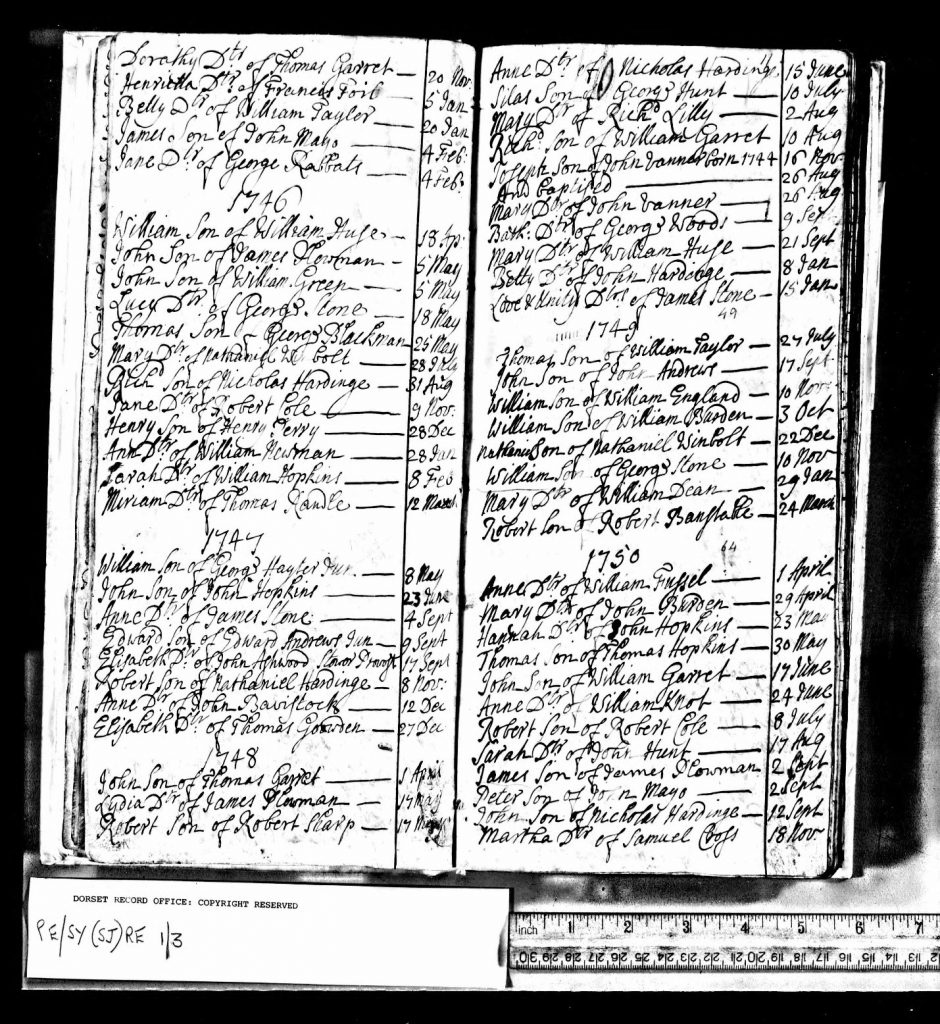
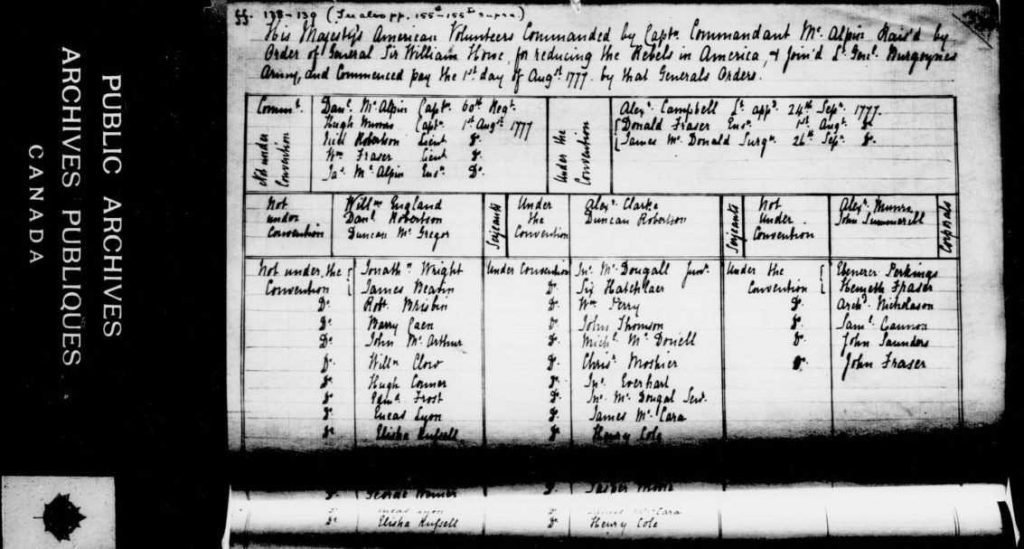
John Phillips 1751-1844
John Phillips was descended on his Father’s side from Dutch immigrants to New Amsterdam (later New York) in the 1600s. In ensuing generations, the family migrated up the Hudson to Albany and Schenectady New York. The photo above is of the Mohawk river valley where they owned land near Schenectady, New York. His Mother’s ancestors were English immigrants to the New England Colonies.
At the start of the “troubles” in 1776, John was living with his mother and siblings in Cumberland County, New Jersey, where he helped maintain a substantial apple orchard.
Phillips, at age 25 or 26, had first enrolled in the West Jersey Volunteers. This unit was raised earlier in 1777 while the British Army was in Philadelphia. These men came from Salem, Gloucester, and Cumberland Counties. John Phillips was first transferred to the First Battalion, New Jersey Volunteers, under Lt. Col. Joseph Barton. After August 1778, he was promoted to Corporal, and moved to the Second Battalion, New Jersey Volunteers, commanded by Robert Drummond.
“Drummond was a wealthy merchant and ship-owner at Acquakanonk Landing, New Jersey. When trouble between this country and England first became apparent, his thoughts and counsel were with the American cause; he was a member of the Provincial Congress and its speaker for two terms, but when war broke out he tendered his services to his king and organized the Second Battalion of New Jersey Volunteers and was commissioned its major. He enlisted about two hundred men, principally from the Bergen county side of the river. He saw service in the South, where most of his men fell victims to disease consequent upon the climate. He was later promoted to Major. After the war, Drummond removed to England, where he died in 1789.”
The New Jersey Volunteers received their uniforms in April of 1776. The uniforms were green and white. Thereafter, their enemies often referred to them as “The Greens”.
For more detailed information on the New Jersey Volunteers, see the online history from the Loyalist Institute, at http://www.royalprovincial.com/military/rhist/njv/3njvhist.htm.
In August 1778, John Phillips was in a military hospital for unknown reasons, on Staten Island. John was possibly treated by a doctor named ‘Archibald Campbell’, which may account for the fact that John named his first son ‘Archibald’.
By November 1779, the company was in good order at Savannah:
Muster Roll, Captain Robert Drummond’s Company, Third Battalion, New Jersey Volunteers, Savannah GA, 29 November 1779 … [many names and ranks] Corporal John Phillips.”
“On 14 September 1780, Col. Robert Drummond’s Battalion of the New Jersey Volunteers were camped at Fort Grierson, near Camp Augusta in Georgia. They did not suspect that a combined rebel force was approaching on three fronts. The Rebel forces were led Col. Elijah Clarke. Col. Clarke sent one element of his forces under Major Samuel Taylor to attack the Loyalist Creek Indians at Indian Springs. He sent a second element under Col. James McCall to circle south of Augusta and attack towards St. Pauls Church and took the largest group with himself, to attack Fort Grierson. As the Loyalists had superior forces, he had to depend on strategy and surprise. It turned out that he was successful, and the Southern Campaign took significant losses and humiliation over the four days of battle which followed.
St. Paul’s (old Fort Augusta) and Fort Grierson (under Drummond and the New Jersey Volunteers) were incapacitated. At Grierson, one soldier was killed, one sergeant and five soldiers were wounded, and Robert Drummond and eighteen others were made prisoner. Col. Clarke released and armed over seventy Rebel soldiers who had been in jail, seized Indian “presents” valued at over £ 4,000, and “liberated” much of the arms and ammunition that had been turned over by surrendering Loyalist forces. In the course of the ensuing firefight through the streets of Augusta, Captain Andrew Johnson, of the King’s Carolina Rangers, was killed. “
This week’s events spelled the end of the Southern Campaign in Georgia and South Carolina. By the end of December 1782, it was all over. Charlestown with the NJV sailed back to the British garrison at New York. Finally, the N.J. Volunteers arrived in Parrtown (later St. John) New Brunswick in October of 1783 aboard armed ships of the British fleet.
The next service recordstates:
“Muster Roll, Major Robert Drummond’s Company, Third Battalion, New Jersey Volunteers, Dutch Kiln’s, Long Island, New York, 25 December 1782 to 23 February 1783, 61 days inclusive …” the entire company there, including Corporal John Phillips. The Company has been evacuated to Long Island, New York.
It is estimated that 14,000 Loyalists from many regiments and companies, were resettled in New Brunswick after the war ended in 1783.
Just before or after the muster role starting December 25 1782, John Phillips was married to Isabella Phinney.
John Philips and Isabella Phinney married 178—— ” [year, month, and date missing.]
Their first child, Archibald Phillips, was born 1783 in New Brunswick.
The marriage record, noted in Schenectady, shows that this was the Phillips family cluster to which John was connected, even though his immediate family had been in New Jersey at the outbreak of the war. Isabella Phinney (1763 – 1849), wife of John Phillips is probably the daughter of Peter Phinney (1737 – 1824). Peter Phinney appears on “The Old United Empire Loyalist List”, as follows: “Eastern District, Soldier Royal Regiment of New York, Muster Roll. P.L.N.J. 1786”, with his son George Phinney. However, Peter Phinney appears to have recanted and returned to the U.S.A. after 1786. John Phillips named his third son Peter, born in 1786, and his youngest son George, born in 1812, perhaps in honor of his Phinney in-laws.
At the end of the American Revolution, John Phillips was among those Loyalists who
were first resettled to Parrtown, Nova Scotia, (later New Brunswick). His name is found on the “Post War Settlement; 2nd Battalion New Jersey Volunteers [List of names of officers and men of the 2nd Battalion, New Jersey Volunteers, who received grants of land in King’s County, New Brunswick. Dated 14 July 1784.]
John filed a petition for land at Woodhouse, Norfolk County, Ontario, in 1801, as follows:
“12 Feb 1801: John Phillips, Woodhouse – was in his Majesty’s service during the whole of the Revolution in America in the capacity of a Corporal in the 2nd Battalion, New Jersey Volunteers commanded by Colonel Isaac Allen; discharged at St. John, New Brunswick; now in the Province with an extensive family of a wife & 7 children & without any land to support them; requested a grant; OC – Recommended for 200 acres.”
In June 1787, John Phillip’s lands in New Jersey were confiscated:
“A list of the names of all those Persons whose property was Confiscated in the Several Counties of the State of New Jersey, for joining the Army of the King of Great Britain &c. as returned to the Auditors Office, previous to the first day of May 1787………………………………………… Cumberland
County NJ …. John PHILIPS… others… Extract from the publick books in my office given under my hand this first day of June, One Thousand seven hundred and Eighty seven.”
“25 Oct 1806 (W8/34) John is signer of a general petition of Loyalist officers and soldiers resident in the London District who came from New Brunswick to Upper Canada, requesting a grant of lands and their names on the U.E. List. (Woodhouse, Norfolk County).”
John Phillips died on 29 July 1844, and his wife, Isabella, died on 13 October 1849. They were buried on their family farm in Ekfrid Township, Middlesex County, about fifteen miles south of Glencoe, Ontario. Many of the children moved on, in the 1850s, to Camden Township in Kent County, and the family farm changed hands.
About forty years ago, their grave markers were found by a descendant, resting against a tree. The man who owned the farm requested that the stones be taken away as they meant nothing to his family who had owned the property for many years. They had never heard of John Phillips. The vigilant descendant, Harold Carruthers of Glencoe, picked up the stones and they are now cemented in the Willy Cairn, a few miles away; The Willey Cemetery in Middlesex County, Ontario.
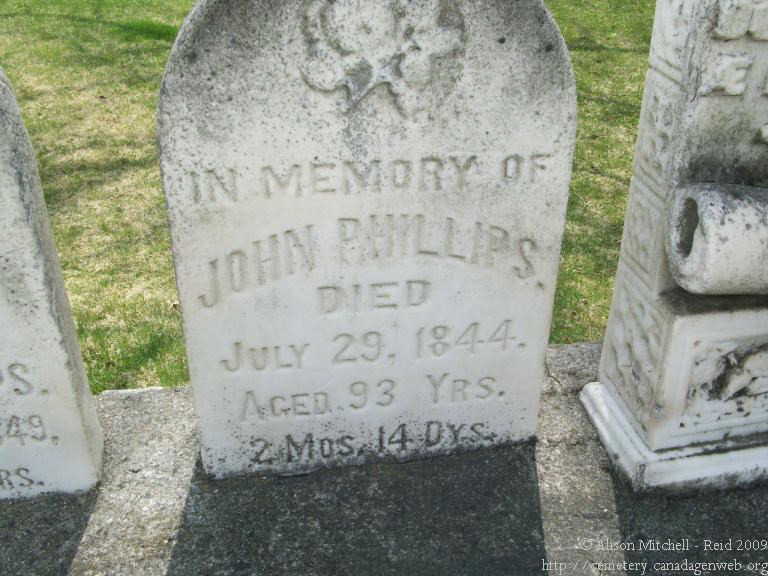
The Henrys and Starks of Virginia
The Stark and Henry Families of Virginia married in the Fike family when Frances Henry married Thomas Lanman Fike.
Frances Henry’s mother Sarah Stark married Thomas Henry in Robertson County Tennessee. They were both descended from colonial immigrants to North America who fought in the Revolutionary War and then migrated over the Appalachian Mountains to settle newly opened territory near present day Nashville.
The first Stark immigrants were Sarah’s 2nd Great Grandparents, James Stark and Elizabeth Thornton. They were born in Glasgow, Scotland and came to Stafford County, Virginia around 1720. He was a slave owner and tobacco farmer who owned 230 acres of land.
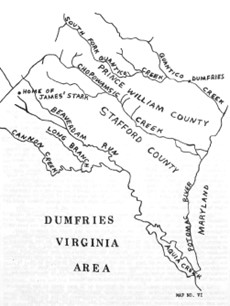
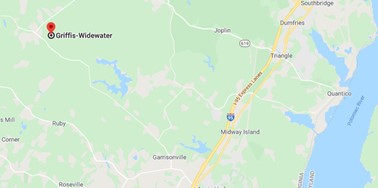
James Stark 1756-1835
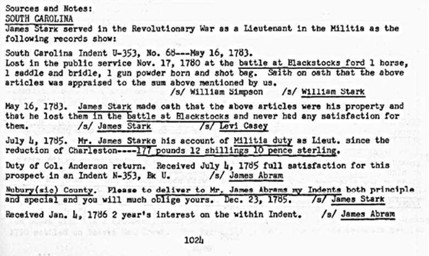
Sarah Stark’s grandfather James was an officer of the South Carolina militia during the Revolutionary War. He was born in Virginia and fought in the South Carolina Militia during the battle of Blackstone’s Creek. A description of the battle is available on Wikipedia.
After the war, the Stark family joined in the Western migration into newly opened lands and settled on land Northeast of Springfield, Tennessee – just North of Nashville. The Fyke family moved to Tennessee at the same time and settled several miles west of the Starks on the other side of Springfield in an area known as Fyke’s Grove. Sarah Stark married Thomas Henry in Robertson County, Tennessee in 1830. Their daughter Frances was born there in 1837. Sometime between 1843 and 1854 the Henry family moved with the Fyke’s and Robertsons to Marion County, Illinois where their daughter Frances married Thomas Lanman Fike.
Most of the Stark’s stayed in Tennessee. The Revolutionary War soldier and one of his sons moved to central Missouri and settled on land granted for service in the War.

According to letters and other data left by Marie Rogers Daley, great-granddaughter of Thomas W. Stark, James Stark left Pulaski Co with his son John W. Stark and moved to what is now Hickory Co, MO. Marie Daley said that James Stark was buried in Hickory County in the family lot of his son John W. Stark. This cemetery would be the old Turner Cemetery where John W. Stark and wife Elizabeth Todd are buried. A tall tombstone stands in the Turner Cemetery. Inscriptions for John W. Stark and wife Elizabeth Todd are on opposite sides of the four-sided monument. On the third side of the monument is roughly chiseled the word “Grandfather”. This tombstone was erected years after the deaths of John W. and Elizabeth Stark. Very probably the chiseled inscription “Grandfather” refers to James Stark. This cemetery is on private land.
Thomas Henry
My 3rd great-grandfather Thomas Henry was Thomas Lanman Fike’s father in-law. He is descended from Scottish, Welsh, and English immigrants. They were predominantly wealthy adventurers who arrived after the colony was established and tobacco production was at its peak. He is the 4th cousin twice removed of the confederate president Jefferson Davis and the second cousin once removed of the wife of President Andrew Jackson.
Thomas was born in Robertson County Tennessee in 1811. His father, Hugh, made the treacherous journey as a young man in the flotilla led by his grandfather Col. John Donelson down the Tennessee river to settle what is now Nashville. The image at the top of this page is an engraving made to represent the Donelson flotilla. It is there in North central Tennessee where the Henry, Stark, Richardson, and Fyke families came together. They intermarried and later migrated West to Missouri and Utah.
Thomas and his wife Sarah Stark moved to Marion County Illinois along with the Fykes and Robertsons in the 1840s as a part of the Westward migration that settled in the Mississippi River basin before the Civil War.
The Henry immigrants to North America were Alexander Henry 1680-1735, His wife Jean Robertson 1684-1735, their son Hugh 1715-1791, and his brothers. They were all born in Aberdeen, Scotland and came to Virginia in the 1730s. The Revolutionary War patriot Patrick Henry was Alexander’s grandson and a distant cousin. The Robertsons were also from Scotland. They settled in Maryland a generation earlier than the Henrys. John Donelson was an officer in the Revolutionary War and a business partner of the founders Jefferson, Madison, and Washington in land speculation. He led one of the expeditions to settle Tennessee after the war.
Hugh Henry was the son of Alexander and Jean Robertson. Jean’s brother, Nicholas Robertson, was the grandfather of General James Robertson, the leader of the Regulator Movement in North Carolina. In 1770, after the collapse of the Regulator Movement, sympathizers from that colony under James Robertson fled and established homes farther west on the Watauga River, effectively beyond the reach of the colonial authorities. Hugh Henry was with his cousin, James Robertson, in Watauga and in 1779 they led a settlement party to the banks of the Cumberland River in the Nashville Basin and founded Fort Nashborough, which later became Nashville.
Hugh Henry 1751-1834
Hugh Henry, Junior was born on 25 June 1751 in Lunenburg (Pittsylvania) County, Virginia. He served the Revolution in 1777 as a lieutenant and sergeant in Captain John Donelson’s Company of Colonel Evan Shelby’s Virginia Regiment in the Continental Line of North Carolina and participated in the Cherokee campaign. In 1778, he served as a private in Colonel George R. Clark’s Illinois Regiment in the Kaskaskia campaign, along with his brothers David and Isaac.
In 1779, the Henry family accompanied Colonel John Donelson aboard the flatboat “Adventure” on the arduous expedition led by Donelson and Captain James Robertson that would result in the settlement of French Lick, site of the present day city of Nashville, Tennessee. Hugh married Elizabeth Tamnasson on 17 December 1800 and established residence in Robertson County, Tennessee, where in 1782 he, his father and brothers had been granted land for their military service.
He was commissioned Justice of the Peace in 1796, became the first Sheriff of Robertson County in August of that year, and on July 30, 1800, was commissioned by Governor John Sevier as Second Major in the county militia. He applied for and was granted a Revolutionary War pension in 1832 and died on 17 April 1834. The site of Hugh’s grave, which is believed to have been destroyed in a calamitous flood, is unknown.
John Donelson 1718-1785

Our Donelson ancestors were influential in the founding of our republic and the early Westward settlement. Our 5th great-aunt Rachel Donelson was the First Lady of the United States – married to Andrew Jackson. John Donelson and his wife Rachel are buried in the churchyard on the grounds of Andrew Jackson’s plantation, “The Hermitage”, near Nashville. Their lives are well documented but I will copy a few brief biographies here:
Our immigrant ancestor John Donelson 1698-1736 (Revolutionary War Patriot’s father) was a Scottish ship owner from Edinburgh. He was engaged in trade from Virginia to London around 1716. He married a Virginian, Catherine Davies, and had one son also named John in 1718.
“John Donelson (Patriot), land speculator and early settler of Middle Tennessee, led over one hundred settlers on a tortuous water journey to the Cumberland settlement during the winter of 1779-80. Donelson was one of the earliest settlers of Pittsylvania County, Virginia, although the date of his arrival in Virginia is not known. His father and grandfather were involved in planting, commerce, and shipping. An educated man for his time, Donelson was the surveyor for Pittsylvania County from 1767 to 1779. He was a member of the House of Burgesses from 1769 to 1774. In 1771 he was appointed to survey the state line and found that three settlements thought to be in Virginia were within the boundaries of North Carolina. In 1775 he became county lieutenant, with rank of colonel, and served in campaigns against the Overhill Cherokees. As a result of Donelson’s survey of the Cherokee line, he acquired a large land claim west of that line and attended the Cherokee treaty signing at Fort Patrick Henry, near the Long Island of the Holston, in 1777.
Richard Henderson selected Donelson and James Robertson to lead settlers into this Cumberland River region. Robertson made plans for an overland voyage while Donelson led another group along a water route. Donelson and approximately thirty families embarked from Fort Patrick Henry on December 22, 1779. Their boat, the Adventure, accommodated several families, household goods, and supplies necessary to sustain a settlement in a new land. At the mouth of the Clinch River, another group of emigrants joined Donelson’s party. He led this flotilla of thirty or so canoes, flat boats, and dugouts on an expedition traversing the Holston, Tennessee, Ohio, and Cumberland Rivers.
The fleet carried many women and children. Donelson’s own large family, including his wife Rachel Stockley, their children, and approximately thirty African American slaves, were among the travelers. One of Donelson’s children was his thirteen-year-old daughter Rachel, who would become the wife of Andrew Jackson. Others in the party included James Robertson’s wife, Charlotte, and five of their eleven children.
(Our ancestor Hugh Henry was also part of the flotilla and married Donelson’s daughter Mary)
Donelson kept an account of his historic journey and of the hardships they endured. On December 22 he made his first entry in his “Journal of a Voyage, intended by God’s permission, in the good boat Adventure, from Fort Patrick Henry, on Holston river to the French Salt Springs on Cumberland River”
A Partial account of Donelson’s Voyage:
“Because of delays incident to such occasions, the fleets under Colonel Donelson and Captain Blackmore did not sail for nearly two months after the departure of the land farce. Finally, however, the voyage was begun by each about the same time; Donelson’s party from Fort Patrick Henry, five or six miles above the north fork of Holston River, and that commanded by Blackmore, from Blackmore’s Fort on Clinch River. Of the adventures of the latter we know but little until after they were united with Donelson’s fleet at the mouth of Clinch River some time thereafter.
Colonel Donelson was aboard the “Adventure,” the largest boat in the flotilla, and for this he kept a journal in which was recorded all the principal events of the journey from the time of sailing until it reached the French Lick four months later. Fortunately this document has been preserved and is now m the archives of the Tennessee Historical Society at Nashville. It is styled a ”Journal of a Voyage intended by God’s permission in the good boat Adventure from Fort Patrick Henry on Holston River to the French Salt Springs on Cumberland River, kept by John Donelson.” From this journal we gain the information that the first mentioned wing of the fleet took its departure from Fort Patrick Henry on December 22d. At that time, as we have already seen, the land party was within a few days of its destination. From there the Adventure and its companion boats fell down the river to Reedy Creek where they were stopped by low water and excessive cold. Here they remained for some time, finally reaching the month of Cloud’s Creek on Sunday evening, February 20, 1780. They passed the mouth of French Broad River on Thursday morning, March 2. About noon that day one of the boats which was conveying Hugh Henry and family ran on the point of William’s Island two miles above Knoxville, and by force of the current sank. The freight therein was much damaged, and lives of passengers greatly endangered. Colonel Donelson ordered the whole fleet tied up while the men of the party assisted in bailing the sunken boat and replacing her cargo.
The same afternoon Ruben Harrison, one of the party, went hunting in the woods along the shore and did not return. During the afternoon and night many guns were fired to warn him. Early next morning a small four-pound cannon, the property of Robert Cartwright, and which was mounted on the Adventure, was also fired, the voyagers hoping thereby to attract the attention of the lost man. Numerous parties were sent out to scour the woods, but all to no avail. On Saturday morning, March 4th, after leaving the young man’s father and the occupants of a few boats to continue the search, the main body moved off downstream. About ten o’clock that day young Harrison was found and taken aboard from the shore some miles below, to which place he had wandered the day before. The party camped that night on the South bank of the river in Loudon County, near the present beautiful and picturesque site of Lenoir City.
Sunday morning, March 5th, the fleet was under way before sunrise, and at noon passed the mouth of Clinch River in Roane County, where Kingston now stands. Three hours later they overtook the boats under command of Captain Blackmore, the whole party camping again that night on the shore.
Donelson’s Journal does not record the number of boats in this fleet, but James Cartwright, for many years a citizen of Gallatin, and whose father, Robert Cartwright, was with Donelson on the Adventure, related that when the boats from the Holston united with those from the Clinch they were about forty in number. These consisted of scows, canoes and pirogues, the latter being a kind of rude craft hollowed out from the trunks of trees. Nearly all the boats had two or more families aboard. In the combined party there were a hundred and thirty women and children, and about fifty men.
The cargo consisted of the household goods and personal effects of those aboard and of, those who had gone with Robertson by land. The Adventure carried the largest number of passengers. Among them were the wife and five children of James Robertson, Robert Cartwright and family, and Colonel Donelson’s family, including his daughter, Rachael, who afterwards became the wife of General Andrew Jackson.
The flotilla now proceeded in a body. During Wednesday, March 8, they came to the first inhabited Indian town on the Tennessee River near Chattanooga. Its inhabitants were of the treacherous Chickamauga tribes, who, on sighting the boats, came flocking to the river and insisted that the voyagers should come ashore. They gave signs of friendship calling the whites brothers and addressing them in other familiar terms, insomuch that John Donelson, Jr., and John Caffrey took a canoe and rowed toward them, the fleet having anchored on the opposite shore. When Donelson and Caffrey were about midstream they were met by Archie Coody, a half-breed, and several other Indians who warned them to return to the fleet. They did so, followed by Coody and his companions. The latter seemed friendly, and Colonel Donelson distributed among them presents, with which they were much pleased.
Looking across toward the village just at this time they saw a large party of Indians armed and painted in red and black, embarking in canoes on the other side. Coody at once made signs to his companions ordering them to quit the fleet, which order they readily obeyed, while he remained with the whites and urged them to move off at once. The boats were scarcely under way again when they discovered the village Indians, still armed and bedecked in war-paint, coming down the river, seemingly to intercept them. However, the whites were not over-taken. Coody rowed along in his canoe with the fleet for some time, but finally assuring Colonel Donelson that he had passed all the Chickamauga towns and was, therefore, free from danger, turned about and rowed back toward the first village.
The whites had not proceeded far, however, before they came in sight of another mud cabin town situated likewise on the south side of the river, and nearly opposite a small island. Here the savages again invited them to come ashore, calling them brothers as on the previous occasion. However, the settlers were too wise to be led into such a trap, and headed their boats for the opposite channel around the island. Seeing this, the Indians called to them through one of their number who could speak English, telling them that the channel chosen was unsafe, and that their side of the river was much better for such passage.
Captain Blackmore’s boat ran too near the northern shore, and was fired upon by a band of Indians who lay concealed near the bank. Young Mr. Payne, who was aboard the craft, was killed as a result of such an unexpected volley.
There was with the flotilla a boat carrying twenty-eight passengers, among whom an epidemic of smallpox had broken out. To guard against a spread of this disease to other members of the fleet agreement had been made that it should keep well to the rear, its owner, Mr. Stuart, being notified each night by the sound of a hunting horn when those ahead went into camp. Therefore, this unfortunate party was far behind while the events above mentioned were taking place. When they came down opposite the towns the Indians were on the shore in large numbers and seeing them thus cut off from the rest of the fleet swarmed out in canoes and with cold blooded, murderous intent killed and captured the entire crew. Cries of the latter were distinctly heard by those in the boats ahead, but they were unable to stem the swift current and thus return to aid their perishing comrades.
But the Indians suffered a swift and righteous retribution for this wanton act of cruelty. They became infected with the disease of their victims, and for many months thereafter smallpox raged, not only among the Chickamaugas, but in the tribes of their neighbors, the Creeks and Cherokees. When stricken with the malady and while the fever was yet upon them, the savages would take a heavy sweat in their huts. When driven to madness by the fever and heat, they would rush out and leap into the river, from the effects of which folly they died by scores. Old persons of today well remember the traditional accounts of a great and terrible mortality which prevailed among the savages after the capture of Stuart’s boat.”
On April 24, 1780, Donelson’s party reached the end of their thousand-mile journey and were finally reunited with family and friends at the Big Salt Lick (now Nashville). Within a week of Donelson’s arrival, Henderson prepared the Cumberland Compact, of which Donelson was the fifth signer.
Donelson, his family, and slaves made camp at a tract of land along the rich river bottom of Stones River. He named this site Clover Bottom and planted corn and the first cotton crop to be raised in the area. In July, the Stones River flooded, completely covering the bottomlands where Donelson had planted his corn and cotton. This disaster, as well as recent reports of Indian attacks in the Clover Bottom section, prompted Donelson to move his family to the relative safety of nearby Mansker’s Station.
Once the floodwaters receded, Donelson learned that his corn and cotton crops at Clover Bottom had matured and decided to attempt to save them. A party composed of his son, Captain John Donelson Jr., Abel Gower Jr., and several others worked for several days to harvest the valuable crops. After gathering the corn, the Gower boat started down the river and was soon fired upon by a party of Chickamaugas. These attacks on the settlements, along with the serious shortage of food, prompted Donelson to remove his family and slaves to a more secure position in Kentucky.
Donelson continued his business dealings, traveling frequently between the lands of Kentucky, Virginia, and Tennessee. While returning from Virginia and Kentucky on business in 1785, Donelson learned that his family had returned to the Cumberland settlement. On his journey to Mansker’s Station he was fired upon by Indians and died along the banks of the Barren River.

Andrew Family Revolutionary War Patriots
Jacobus Quick (1742-1832)
Two of Elizabeth Hoagland’s great-grandfathers (Andrew ancestor) were Revolutionary War patriots:
His Revolutionary War records in the Adjutant General’s office certify that he was in commission as Second Lieutenant, Captain John Ten Eyck’s Company, Second Battalion, Somerset County, New Jersey Militia; Lieutenant in Captain Peter D. Vroom’s Company, Second Battalion, Somerset County, New Jersey Militia; Captain, Second Battalion, Somerset County, New Jersey Militia in Revolutionary War. He served Sundry Tours from 1775 to end of Revolutionary War. In the book “Bergen Family” it is stated that he was a prisoner of war in 1788.
There is shown in this book a photo of an excellent oil painting on wood of Captain Jacobus and Margarita Stryker, his wife. The original painting is in the possession of Mr. Garret Van Pelt, of Pasadena, Calif., a cousin of Margaret B. Manley, great-grand-daughter of Capt. Jacobus, who had purchased it of a lady in New Brunswick, N. J.
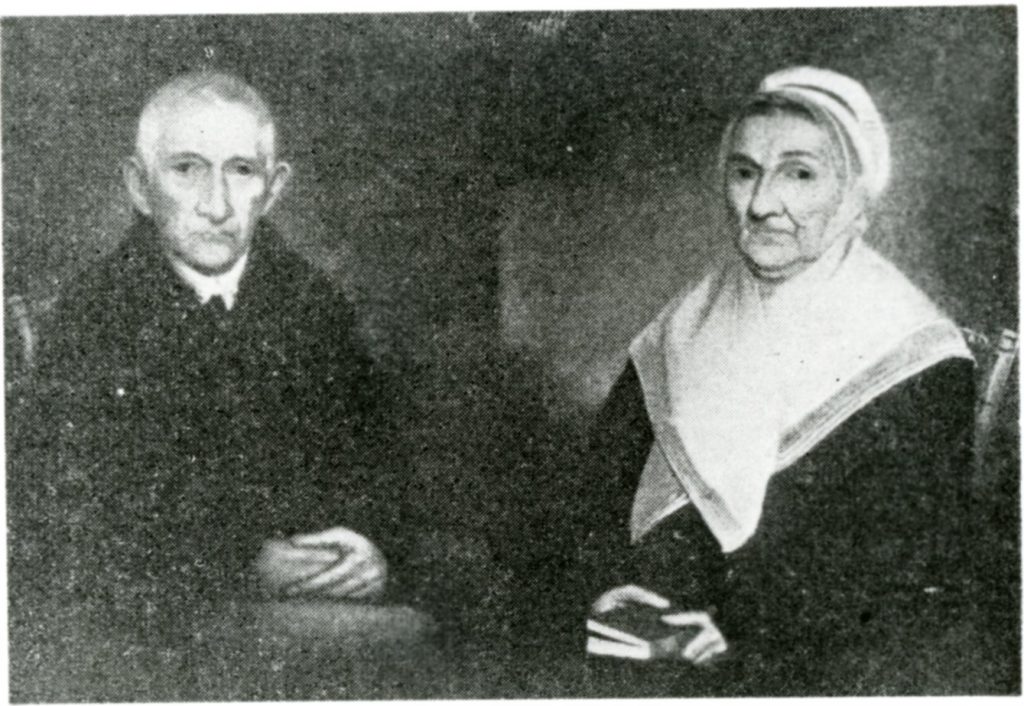
Edward Bunn (1738-1796)
Edward was a paymaster of New Jersey state troops during the Revolutionary War. “Documents relating to the Revolutionary History of New Jersey, Vol III (p. 549): “Wednesday last Edward Bunn, Esq. was elected a Representative in General Assembly, for the county of Somerset, in the room of the Honourable William Churchill Houston, Esq. lately appointed a Delegate in Congress.” Official Register of the Officers and Men of New Jersey in the Revolutionary War (p. 375): Bunn, Edward. Paymaster, Somerset; Paymaster, State troops.”
Edward Bunn was a member of the state assembly for many of the years between 1779 – 1794 and a member of the U.S. Congress.
Lowe Family Revolutionary War Patriot
John Farley Jr. (1751-1816)
John Farley, Jr., (Ancestor on the Lowe side of the family) son of John and Sarah, was born 14 October 1751, died 9 July, 1816, buried in Plum Creek cemetery, White Co., Tennessee. A DAR marker is placed at his grave (DAR Ancestor #: A038636). “John Farley was a Patriot. In a Petition of Officers & Soldiers of Amelia Co., To the VA Convention of James 1776 John Farley was a Signer.”